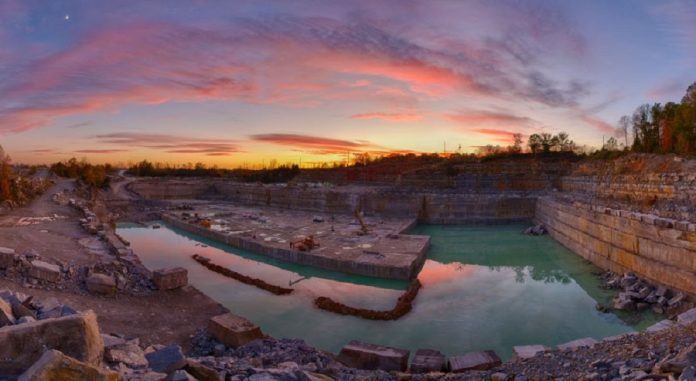Travel, if you will, to the Mississippian Period, 330 million years ago. Most of the US was occupied by a vast, tropical sea. The weather was warm, even hot, due to the fact that North America was parked over the equator, far south from our present, somewhat chilly location.
The water was warm, crystal clear, and not too deep. The sea teemed with life: coral-like bryozoans fanned in the currents, snails grazed along the sea floor, and sharks patrolled the waters. The sediment at the bottom of the sea was a mixture of shell fragments and lime mud, with gentle waves rolling limestone pellets into rounded grains. Sounds kind of nice, doesn’t it?

This inland sea left behind a blanket of limestone hundreds to thousands of feet thick. Mississippian-age limestones cover huge swaths of the US, creating famous building stones in Indiana, caves in Kentucky, the prominent Redwall Limestone in the Grand Canyon, and the familiar Madison Limestone cliffs throughout the mountains of western Montana.
So, next time you come face-to-face with a limestone slab in a showroom, pause and indulge yourself with a little mental time travel to the prehistoric, balmy ocean that created this stone.
Quarries throughout the Midwest have been making use of the Mississippian seabed for nearly 200 years. Skyscrapers, universities, and city buildings from coast to coast are clad in limestone, primarily quarried from Lawrence, Monroe, and Owen counties in Indiana. There, a 60-foot thick layer of Salem Limestone produces a uniform, non-layered, grey stone with a smattering of fossils.
Salem limestone is used in all 50 states, on buildings as utilitarian as post offices, as soaring at the Empire State Building, and as robust as the Pentagon. Look around your own city and see if you can spot some Salem Limestone. It’s far from flashy, and at first it looks a lot like concrete. But sidle up and look close, and you’ll see fossil fragments. Be warned though, that people will think you’re a little nuts when they watch you press your nose up to the post office!
Thanks to our former inland seas, the US is home to many limestone quarries, generally arranged in a north to south band through the country’s midsection. (The Mississippian Period is named because these rocks are plentiful in the Mississippi River valley.) Texas, Kansas, Indiana, Illinois, Minnesota, and Wisconsin all produce architectural limestone, satisfying a need for locally derived, native stone that has not traveled halfway around the globe.
Most limestones form in the same basic way. They are made of shells, fragments of corals and similar creatures, and the teeny tiny shells from plankton. All of this stuff is made from calcite – calcium carbonate – an abundant mineral in geology. When the marine creatures die, their shells drift to the sea floor. Sometimes currents and waves grind the shells into pieces. Other times, the shells dissolve into the seawater for a while, before settling out as very fine lime mud. In either case, the sediments pile up in layers and eventually get compressed enough to form solid stone. If you look close at a few different limestones you can usually recognize some of the common ingredients:
Limestone is not just an artifact of ancient seas. It forms today in places like the Florida Keys and the Bahamas. Enticing images of tropical beaches show milky-hued, blue-green seawater; the light color is from calcite dissolved in the ocean water. Eventually, that will settle to the sea floor and make a new layer of limestone.